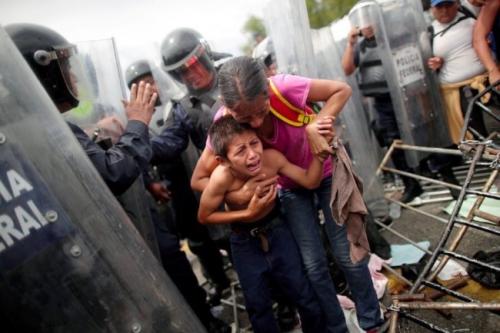Forced migration, human rights and exclusion processes in contemporary Mexico
- Opinión

"For those [migrants] who do not die in transit and are not immediately captured and returned, a spectral existence of" invisible men "awaits them, exploitable bodies without documentation that guarantees them minimal rights. They will be tolerated, exploited and permanently threatened at the same time". José Antonio Zamora, 2017.
In the current context, international migrations have increased dramatically [1] and have been related and caused by multiple economic and socio-political processes produced by neoliberal globalization (the increase in inequality and the deterioration of the productive structure, the increase in poverty and the concentration of wealth, the lack of jobs and well-paid wages, the growth of violence derived from impunity and structural corruption, among others). At the level of the Central and North American regions, and as shown by the data and findings of the 2019 Report (Migrations in Mexico: borders, omissions and transgressions) of the Documentation Network of the Organizations Defending Migrants (REDODEM) [2], Mexico, which had traditionally been a country of origin / expulsion of millions of migrants to the United States (US), has established itself as a transit territory for hundreds of thousands of Central Americans, and, to a lesser extent, as a destination for these excluded populations. But it is also a place of reception for the forced return migration of its own citizens, and a national territory with processes of forced internal displacement.
The 2019 REDODEM Report shows that one of the most numerous groups and those with the greatest vulnerability and risk in irregular transit through Mexico are migrants from the Northern Triangle of Central America (with the largest demographic volume being Hondurans, and then Guatemalans and Salvadorans), who mainly go to the US. This migration already has a history of decades, it is caused by a series of structural causes (economic and related to contexts of violence) [3], and in recent years the flows of people involved have increased. This migration has been marked for years by various processes of exclusion and violence, where Central Americans suffer various crimes in their transit through Mexico. Also, in this report the groups of migrants from Haiti and Venezuela, as well as those from Nicaragua and Cuba, stood out due to their demographic dimensions. [4]
2019 stands out as the year of the Migrant Caravans (mainly of Central Americans, and especially of Hondurans), where these groups showed a strong capacity for social agency and organization to carry out their difficult and risky migratory trajectories. Along with this scenario, and as a result of the geopolitical and economic pressure of the current US government on Mexico, various migratory containment actions were carried out in Mexican territory (securitization of borders, deployment of national guard personnel, detentions, criminalization, among other drastic measures). Likewise, the US imposed the Program to Stay in Mexico (Migrant Protection Protocols), which obliges migrants (especially Central Americans who want to request asylum in the US) to remain in Mexico while they carry out their asylum application process in the US.
With this, the US government generated de facto a process of externalization of its borders, as well as political dynamics of extra-territorialization of the asylum procedure. As a result of the above, tens of thousands of irregular migrants, in a clear situation of defenselessness and accentuated material precariousness (without access to work, medical services and social security), are stranded in various places on the US-Mexico border (Tijuana, Ciudad Juárez, Nuevo Laredo and Matamoros). The 2019 REDODEM Report is a useful document, with relevant and highly current information to understand some of the forced migrations between Central and North America in recent years. The 2019 REDODEM Report is freely accessible to the public and can be downloaded at the following link: http://redodem.org/wp-content/uploads/2020/09/REDODEM_Informe_2019.pdf
For Balderrama, thinking that the world can (and above all should) be a fairer place.
NOTES
[1] According to UN figures for 2020, there were just over 270 million migrants worldwide.
[2] The 2019 REDODEM Report can be downloaded at the following link:
http://redodem.org/wp-content/uploads/2020/09/REDODEM_Informe_2019.pdf
[3] REDODEM 2018 Report http://redodem.org/wp-content/uploads/2019/09/REDODEM-Informe-2018.pdf
[4] Press Release of the 2019 REDODEM Report http://redodem.org/wp-content/uploads/2020/09/Boleti%CC%81n-Informe-REDODEM-2019.pdf
Del mismo autor
- Forced internal displacement in Mexico and processes of violence 13/03/2022
- Labor struggles against precarious work and agribusiness exploitation 09/01/2022
- Detentions, deportations, and criminalization of migrants 29/11/2021
- México: detenciones, deportaciones y criminalización de los migrantes 15/11/2021
- Visibility of migrant voices and subjects 18/10/2021
- La decolonialidad y el abordaje de las movilidades humanas transfronterizas 01/10/2021
- Migrants, social organizations, and policies to control cross-border mobility 20/09/2021
- Decoloniality and sense of the production of social knowledge 06/09/2021
- Decolonialidad y sentido de la producción de conocimiento social 26/08/2021
- México: migrantes, organizaciones sociales y políticas del control de las movilidades transfronterizas 09/08/2021
